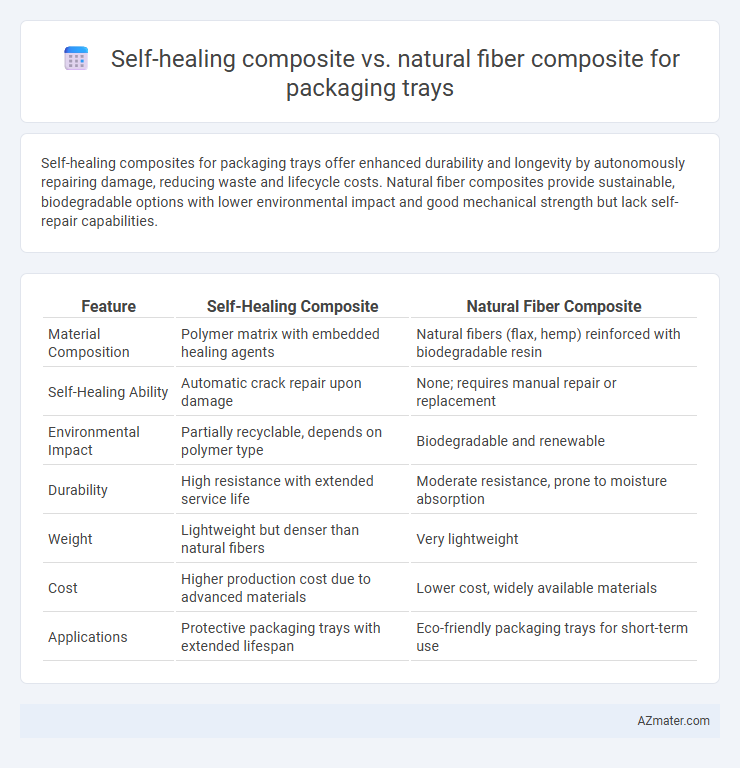Self-healing composites for packaging trays offer enhanced durability and longevity by autonomously repairing damage, reducing waste and lifecycle costs. Natural fiber composites provide sustainable, biodegradable options with lower environmental impact and good mechanical strength but lack self-repair capabilities.
Table of Comparison
| Feature | Self-Healing Composite | Natural Fiber Composite |
|---|---|---|
| Material Composition | Polymer matrix with embedded healing agents | Natural fibers (flax, hemp) reinforced with biodegradable resin |
| Self-Healing Ability | Automatic crack repair upon damage | None; requires manual repair or replacement |
| Environmental Impact | Partially recyclable, depends on polymer type | Biodegradable and renewable |
| Durability | High resistance with extended service life | Moderate resistance, prone to moisture absorption |
| Weight | Lightweight but denser than natural fibers | Very lightweight |
| Cost | Higher production cost due to advanced materials | Lower cost, widely available materials |
| Applications | Protective packaging trays with extended lifespan | Eco-friendly packaging trays for short-term use |
Introduction to Advanced Packaging Materials
Self-healing composites offer innovative solutions in advanced packaging materials by autonomously repairing micro-damages, enhancing durability and lifespan of packaging trays. Natural fiber composites, derived from renewable sources like hemp and flax, provide sustainable alternatives with biodegradable properties and reduced environmental impact. The integration of self-healing mechanisms in natural fiber composites presents a promising frontier for eco-friendly, resilient packaging trays.
Understanding Self-Healing Composites
Self-healing composites in packaging trays incorporate smart materials that autonomously repair microcracks, enhancing durability and extending product lifespan. Unlike natural fiber composites, which rely on renewable plant-based fibers for biodegradability and lightweight properties, self-healing composites utilize engineered polymers and encapsulated healing agents to maintain structural integrity under stress. This innovative technology reduces waste and improves packaging performance by minimizing damage during transport and handling.
Overview of Natural Fiber Composites
Natural fiber composites for packaging trays utilize renewable fibers such as jute, sisal, and hemp, combined with biodegradable or recyclable matrices to offer sustainable alternatives to traditional plastics. These composites provide benefits including reduced environmental impact, lightweight properties, and good mechanical strength suitable for food and consumer goods packaging. Their natural origin and compatibility with eco-friendly manufacturing processes make them increasingly favorable in the shift toward green packaging solutions.
Material Composition and Structure Comparison
Self-healing composites for packaging trays typically incorporate microcapsules or vascular networks embedded within a polymer matrix, enabling autonomous repair of damage and extending material lifespan. Natural fiber composites combine bio-based fibers such as hemp, flax, or jute with biodegradable or thermoplastic resins, offering lightweight, sustainable alternatives with enhanced mechanical strength. The polymer matrix in self-healing composites provides dynamic recovery functions, whereas natural fiber composites rely on fiber-matrix interfacial bonding and fiber architecture for structural integrity and biodegradability.
Mechanical Properties and Durability
Self-healing composites exhibit superior mechanical properties, including enhanced tensile strength and impact resistance, due to their ability to autonomously repair micro-cracks, significantly extending durability in packaging tray applications. Natural fiber composites offer eco-friendly alternatives with moderate strength and stiffness but typically suffer from lower durability and moisture sensitivity, limiting their lifespan under mechanical stress. The self-healing capability of advanced composites ensures prolonged service life and reliability, making them more suitable for high-performance packaging trays requiring repeated handling and impact resistance.
Environmental Impact and Sustainability
Self-healing composites in packaging trays reduce waste by extending product lifespan through autonomous damage repair, minimizing resource consumption and landfill contributions. Natural fiber composites leverage renewable plant-based materials, offering carbon sequestration benefits and biodegradability that lower environmental footprint compared to synthetic polymers. Both materials advance sustainability by decreasing reliance on non-renewable resources, but natural fiber composites excel in end-of-life compostability, while self-healing composites prioritize durability and long-term usage.
Cost Analysis and Economic Viability
Self-healing composites for packaging trays typically incur higher initial manufacturing costs due to advanced material synthesis and embedded healing agents, whereas natural fiber composites offer cost-effective raw materials with lower processing expenses. Economic viability favors natural fiber composites in large-scale production because of their biodegradability, renewability, and lower capital investment, supporting sustainability-driven market demands. Life cycle cost analysis reveals that while self-healing composites may reduce long-term maintenance and replacement costs, natural fiber composites provide immediate cost savings and circular economy benefits ideal for eco-friendly packaging solutions.
Application Performance in Packaging Trays
Self-healing composites offer enhanced durability and extended service life for packaging trays by autonomously repairing micro-cracks, reducing maintenance and waste. Natural fiber composites provide lightweight, biodegradable alternatives with good mechanical strength and cost-effectiveness but lack self-repair capabilities, limiting their longevity under repeated stress. In packaging applications, self-healing composites excel in high-impact and reusable trays, while natural fiber composites are ideal for single-use, eco-friendly solutions where sustainability is prioritized.
Challenges and Limitations
Self-healing composites for packaging trays face challenges such as high production costs, complex manufacturing processes, and limited availability of self-healing agents, which hinder large-scale commercialization. Natural fiber composites pose limitations including moisture absorption, inconsistent fiber quality, and lower mechanical strength compared to synthetic alternatives, affecting durability and load-bearing capacity. Both materials require advancements in compatibility, environmental resistance, and scalability to meet the stringent demands of packaging tray applications.
Future Prospects in Packaging Innovation
Self-healing composites offer enhanced durability and extended lifespan for packaging trays by autonomously repairing micro-damages, significantly reducing waste and maintenance costs. Natural fiber composites provide a sustainable alternative with biodegradable and renewable resources, aligning with increasing environmental regulations and consumer demand for eco-friendly packaging. Future prospects in packaging innovation emphasize integrating self-healing mechanisms into natural fiber composites to achieve high-performance, sustainable trays that push the boundaries of durability and circular economy principles.

Infographic: Self-healing composite vs Natural fiber composite for Packaging tray
 azmater.com
azmater.com